Art
Joie de vivre from the
land of Sancho Panza
Fayza Haq
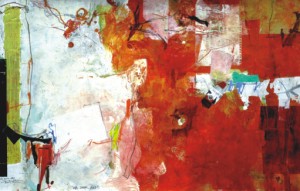 |
Oh Dear Red, oil on paper, 2011.
Photo: courtesy |
Sitting in his Dhanmandi flat on the of eve of his solo at “Chitrak”, Monirul Islam, an artist who has made a name in Spain, where he is now based, speaks of what draws him to his home in Chandpur and friends in Dhaka. He elaborates on his style, technique and influences on his work over tea and toast, before the framers arrive from the venue of his 27th solo. He has received the Order of Queen Isabelle, the highest civil award from Spain – the ceremony for which took place not so long ago in Bengal Gallery–, and held an important workshop at Savar, as Bengal's guest. There he taught painters of over 40 how to use local painting ingredients. This included burnt rice, crushed tiles, oxide, paper boards and recycled paper backings. The mixed media artists included Nilufar Chaman and Mohammad Eunus. They worked on the lawn, verandah, in their rooms etc.
He also held a workshop of young artists, based on nature, displayed at “Shilpangan” fairly recently. Again, he had also taken part in Bengal's “Rooted Creativity” – comprising the cream of Bangladeshi painters– young and old– featuring brilliant artists like Laila Nazli and Saidul Haque Juisse. He is always eager, he says, to show younger artists the local materials that one can work with. Dwelling on the contemporary art world is something he has always enjoyed discussing with Bangladeshi artists. “In the process, I also learn from them.” says Islam, who enjoys working with different organisations in Dhaka. He loves being with his people and using his energy. “In August, I have another workshop in Goya's birthplace Fuentados, in Sargossa”, says Islam. This is aimed at the local Spanish professors.
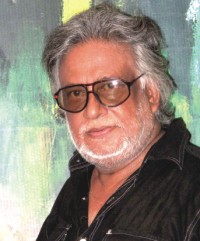 |
Monirul Islam,
Photo: Zahedul I Khan |
Islam plans to stay in his country for six months every year, working, exhibiting and exchanging ideas with the local artists. The other six months will be spent in Spain, where he has stayed for almost 40 years, learnt and worked. He came last year, when his mother passed away, and stayed on for a while, mixing and mingling with the young Bangladeshi artists, whom he believes to be “very alive–and working in all medias. “The young generation artists are so excited about their work. A month back, I was a jury member of the 'Bharat Bhaban' Bhopal Biennale, India. Fifty countries participated in this, including Bangladesh. I then went to Baroda, which an influential artist organised, and had an excellent workshop with students and professors.”
Economy controls the art market. An artist cannot create his own personal world, says Islam. “There are so many media working today. The computer has globalised the world and changed it in the process. The media is incredibly strong. The climate and eco system in Spain, where I live, encourages a painter. There one finds sunshine, red tiles, the brilliant flowers and the vibrant women – in buoyant coloured clothes– the laughter and gaiety of the people with their fiestas. I'm fortunate to live in one of the most beautiful of countries. Spain– with the Mediterranean light and sea. In the land of Cervantes' Don Quixote and Sancho Panza – one can't help but be overflowing with the exuberance of life. “This, Islam feels, in Andalusia, i.e., in the Southern Spain, with its Arab influence, is alive with joie de vivre. The social life influences the artist and the art world says Islam.
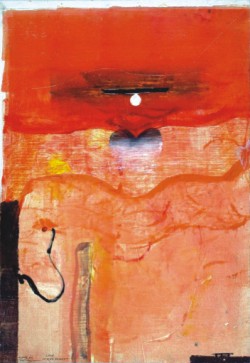 |
Love in Red Planet, oil on paper, 2011. Photo: courtesy |
“Picasso, Miro Salvador Dali and such painters have influenced me strongly with their zest for life. The fascinating museum 'Prado' has so much to learn from. There are maestros like Velázquez, Goya, whose lust for life stirs artists, like me in the 21st century. Goya did a lot of etchings. He knew the aqua tint which the Dutch painter Rembrandt didn't know, says Islam.
Islam had the opportunity to rub shoulders with more recent painters, like Antonio Saura and Antonio Lorenzo as well as Fareie. "Of course, Antonio Tapis has world wide influence" says the master – painter. Islam says that he loves his work; his concept of space; and his influence of Zen philosophy, as well as the Chinese calligraphy – which Tapis had studied.
Islam says that we are inclined to look to the west. He says that we did not get as rich a heritage as our neighbour India. Being influenced by their religious environment which encourages figure representation, they are surrounded by sculpture and painting from the outset. “I found in Al Hamra, Andalusia mosques and palaces there is no representation of living things; However, the highest cultural revolution or the West began in Spain e,g. Esher, from Europe made the only impossible painting in the water is going up–being influenced by the Arabs of the Dark Ages, who brought Renaissance of Europe. The harmony, repetition, with no empty space left in between in the geometrical designs was Esher's style.
“I began experimenting with the local materials in Bangladesh, and that is why I am staying on for a long time here– to study the art world here, having exchanged ideas with other artists here. My experiment with red and yellow colours, taken from nature around me, will not die off soon, despite the wet muggy monsoons. The burnt rice colours, for instance, is something I learnt from Morocco, and passed on here to other painters in Bangladesh. I also love to work on cardboard or recycled packet paper. I also love to work on paper – which I make myself. For me, art is vital: One has to love one's materials. One has to be very honest with his work."
Art itself is something that is jealous: It is dumb–it cannot speak for itself, says Islam. The mind needs rest. Often the brain is jammed with ideas just as at times one is totally worn out, physically. Islam has hundreds of paintings, here in Dhaka, which is unfinished. However, painting ideas grow in the mind themselves. After a respite, going away from work, the colours, lines and forms – assimilate by themselves. For Islam, art is a combination of things around oneself and within oneself.
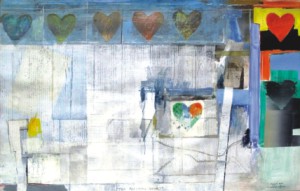 |
The Bleeding Heart, oil on paper, 2011.
Photo: courtesy |
On this occasion at “Chitrak”, Islam is presenting seventy pieces which combines all media. This includes small etchings on sweetmeat packets and 20 pieces of acrylic. Sometimes he uses oil on paper. At times, he works on paper, and then pastes on canvas. Psychologically, one is prepared to pay higher for oil on canvas rather than painting on paper. Twenty-five percent of the viewers ask what do the colours and lines mean, says Islam : In art, he says, there is nothing to understand. “It is same as going out and shopping for crockery or clothes: You like or don't like something. You like the colour harmony and the functional way the object is. Music, for me is stronger than art. When I work, I don't listen to music. I find it difficult to concentrate.” says Islam.
After thirty years of dedicating himself to print it is now blasé for Islam. Islam uses the computer, when some people say that hand work is much better. He will return to etching. But not quite yet. He'd like to work on sculpture: But it's a matter of place and time
Islam says that the artist should firstly be honest about the image he wishes to present. Islam himself doesn't care about whether his work will sell of not. However, he admits that professionally an artist needs to keep an eye on the art market– as he can't afford to be another Vincent Van Gogh. “I don't believe in art prizes in biennales. It never happens that the jury can really pinpoint the best work out of so many, in so short a time. However, when people say that they don't like art exhibitions and art critiques, when two lines appear in the newspaper in his painting's appreciation he looks for scissors to cut out the printed passage in his favour and preserves it.
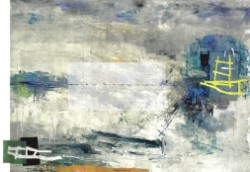 |
The Meghna, oil on paper, 2011.
Photo: courtesy |
“Human beings, after hard work, want some recognition from the viewers. It is natural that they will welcome some money or certificate to continue their profession. The reward is like some oxygen on which painters survive," says Islam. In the 14th, 15th centuries, art in Europe was for the church or the royalty who could pay the patrons. Today, the patrons are bankers and insurance companies, who support the artists, says Islam. The only other change, says the maestro, is that today there are no prohibitions, such as against painting the nudes, unless they were Biblical delineations. Today, Islam says, the artist is a free man.
Is it vital to delineate our traditions and stick to folk motifs as the giants like Zainul Abedin, SM Sultan and Safiudddin had made immortal, four decades back? “My own work is open and light" says Islam. "The atmosphere influences the artist. The culture too has an impact. The thatched huts, cattle, tilling the land, in Zainul Abedin 's paintings are now history. The new generation sees no sail or plough, as I did in Chandpur. Youth, today, do not see the butterflies in the sky and thousands of boats sailing on the river. The socio-political scene and the economy will influence the painter. I've been in Spain for 40 years. Nevertheless, I never could be like the original Spanish. Yet, my work, I believe, is universally appreciated.”
Monirul Islam is as buoyant and full of hopes and dreams–as he was decades back, when he was a young painter in jeans – freshly returned from Spain.
The exhibition, at “Chitrak”which began on May 27, lasts for two weeks.
|
Copyright
(R) thedailystar.net 2011 |
